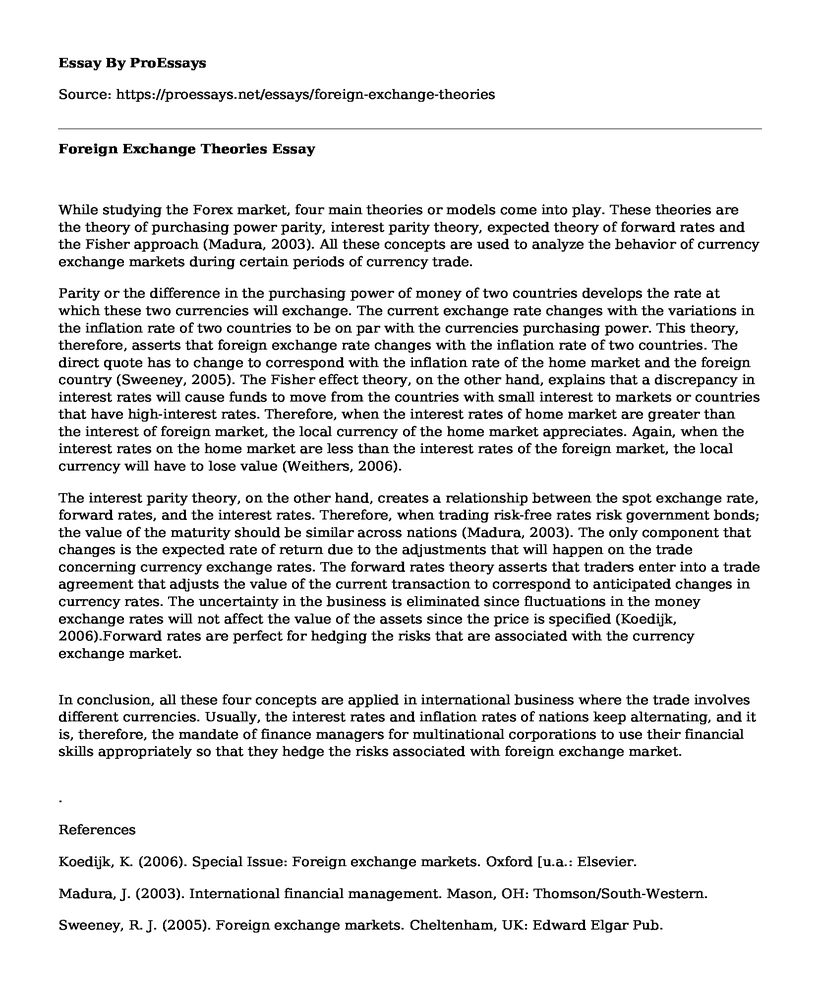While studying the Forex market, four main theories or models come into play. These theories are the theory of purchasing power parity, interest parity theory, expected theory of forward rates and the Fisher approach (Madura, 2003). All these concepts are used to analyze the behavior of currency exchange markets during certain periods of currency trade.
Parity or the difference in the purchasing power of money of two countries develops the rate at which these two currencies will exchange. The current exchange rate changes with the variations in the inflation rate of two countries to be on par with the currencies purchasing power. This theory, therefore, asserts that foreign exchange rate changes with the inflation rate of two countries. The direct quote has to change to correspond with the inflation rate of the home market and the foreign country (Sweeney, 2005). The Fisher effect theory, on the other hand, explains that a discrepancy in interest rates will cause funds to move from the countries with small interest to markets or countries that have high-interest rates. Therefore, when the interest rates of home market are greater than the interest of foreign market, the local currency of the home market appreciates. Again, when the interest rates on the home market are less than the interest rates of the foreign market, the local currency will have to lose value (Weithers, 2006).
The interest parity theory, on the other hand, creates a relationship between the spot exchange rate, forward rates, and the interest rates. Therefore, when trading risk-free rates risk government bonds; the value of the maturity should be similar across nations (Madura, 2003). The only component that changes is the expected rate of return due to the adjustments that will happen on the trade concerning currency exchange rates. The forward rates theory asserts that traders enter into a trade agreement that adjusts the value of the current transaction to correspond to anticipated changes in currency rates. The uncertainty in the business is eliminated since fluctuations in the money exchange rates will not affect the value of the assets since the price is specified (Koedijk, 2006).Forward rates are perfect for hedging the risks that are associated with the currency exchange market.
In conclusion, all these four concepts are applied in international business where the trade involves different currencies. Usually, the interest rates and inflation rates of nations keep alternating, and it is, therefore, the mandate of finance managers for multinational corporations to use their financial skills appropriately so that they hedge the risks associated with foreign exchange market.
.
References
Koedijk, K. (2006). Special Issue: Foreign exchange markets. Oxford [u.a.: Elsevier.
Madura, J. (2003). International financial management. Mason, OH: Thomson/South-Western.
Sweeney, R. J. (2005). Foreign exchange markets. Cheltenham, UK: Edward Elgar Pub.
Weithers, T. M. (2006). Foreign exchange: A practical guide to the FX markets. Hoboken, NJ: John Wiley & Sons.
Cite this page
Foreign Exchange Theories. (2021, Mar 12). Retrieved from https://proessays.net/essays/foreign-exchange-theories
If you are the original author of this essay and no longer wish to have it published on the ProEssays website, please click below to request its removal:
- Time-space Constraints and Depression in Education
- Essay Sample on Learning Strategies
- Rich and Poor Kids Essay
- Love and Romance: The Right Chemistry Essay
- Research Paper on 21st Century: Changes in Business Structures and Employment
- Essay Example on Bipolar Disorder: Assessments & Nursing Diagnosis
- Nursing Self Reflection - Essay Sample







